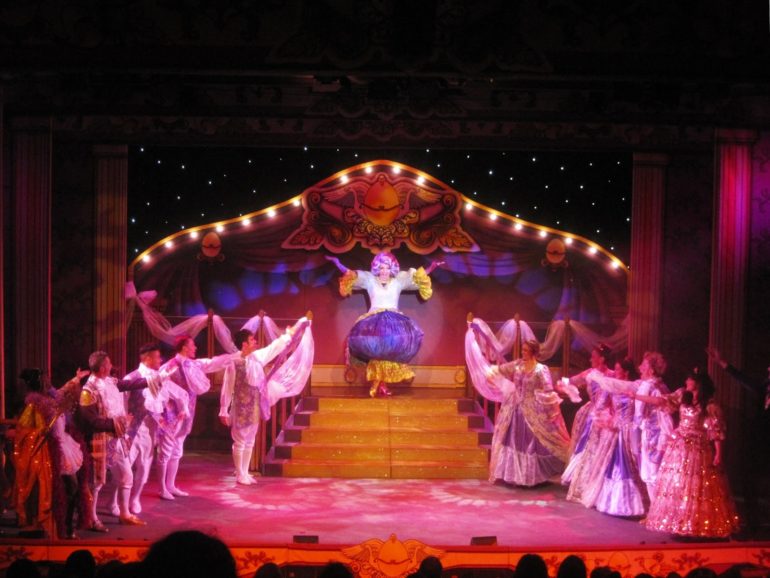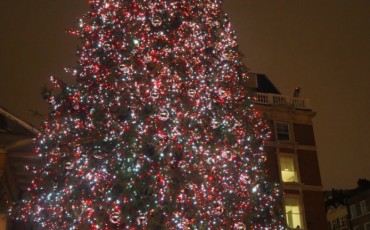Would you like to go to a theatre where you were allowed to shout back at the actors on the stage? The opportunity to do so comes between November running all the way through Christmas until the start of the New Year when Pantomimes take place in many village halls and theatres across the United Kingdom.
Pantomime is a traditional British Christmas treat that is fun for all the family and adults alike and is affectionately referred to as ‘Panto’ and is best described as organised chaos, comedy and fun wrapped around a popular fairy story with lots of audience participation. The stories tell of good versus evil and there is always a happy ending.
Pantomines history in London can be traced back to the 18th century when Italian theatre – Commedia dell’arte influenced comedy through slapstick and dance but no dialogue. The term Pantomime was first used to promote a production in 1717 of The loves of Venus and Mars which was in fact a ballet.
In the 1800s, the Harlequinades (a prototype of Panto) told the story of the eloping lovers Harlequin and Columbine, pursued by the girl’s foolish father, Pantaloon, and his comic servants. The basic plot remained essentially the same for more than 150 years. It would eventually evolve using stories from English literature, folk and nursery tales that very much form the template of Panto today.
 Millfield Theatre Pantomime_Mother Goose. Photo Credit: © Millfield Manager via Wikimedia Commons.
Millfield Theatre Pantomime_Mother Goose. Photo Credit: © Millfield Manager via Wikimedia Commons.
In order to be considered a real pantomime there are certain characters that must be included:
A Dame (“a fella in a frock)– this role requires a large gregarious outgoing personality. Her clothes are often outlandish and very colourful; there will be many costume changes. The make up also has to be exaggerated.
The Immortals are represented by the Good Fairy Queen and the Bad Demon King (you get your chance here to practice your boos and hissing!). Both characters tend to appear or disappear in puffs of smoke!
A Principal boy or Principal girl. The boy must be brave and handsome. Often it is the title role as in Aladdin or Jack and the Beanstalk. He will probably be a poor boy made good. Historically and traditionally this role was played by a girl but it is no longer essential. For the girl she can be a princess or a poor put upon servant girl. What is sure she will be someone that the girls in the audience will be look at in awe and wonder. Maybe dreams do come true as in real life Meghan Markle married a prince!
Here are some of the traditional and most popular Pantos:
Dick Whittington is a story of a poor young man with his cat who comes to London to seek his fortune and eventually becomes the Mayor of London – three times.
Cinderella a popular fairy story is about a poor young girl who is treated horribly by her stepmother and stepsisters who with the help of her fairy godmother goes to a ball and meets a Prince.
Peter Pan – J.M Barrie’s story of a boy who never wants to grow up is a story that is fast becoming part of the traditional list of Pantos. Peter Pan takes the Darling children off to Neverland where they have numerous adventures and meet Peter’s enemy Captain Hook! (Boo Hiss!)
Audience participation makes the Panto such a fun event. Here are some phrases you can practice in a loud voice:
He’s behind you!
Oh no he didn’t!
Oh yes he did!
In recent years there have been a number of American celebrities who made their pantomime debut – Linda Gray, Priscilla Presley, Jimmy Osmond, David Hasselhoff and Henry Winkler to name but a few.
Pantos appeal to all but there are some productions that are for strictly adults only. They push the traditional panto innuendo to absolute limits so do check so there are no surprises.
As you can see there is lot to enjoy at a Panto –make it part of your trip and enjoy a theatrical tradition. Whether they are performed in small village halls or in theatres, Panto make the festive season in the UK a special time for families to have a shared happy experience.
 The Christmas Pantomime colour lithograph bookcover, 1890, showing the harlequinade characters. Photo Credit: © Public Domain via Wikimedia Commons.
The Christmas Pantomime colour lithograph bookcover, 1890, showing the harlequinade characters. Photo Credit: © Public Domain via Wikimedia Commons.







Leave a Reply